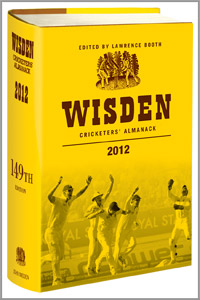The 149th edition of the cricket world's bible, in its familiar yellow and brown cover and with all the usual indispensable features, is out. With 1555 pages, the latest edition is a mammoth production.
Another enduring Wisden tradition dating back to 1889 is the selection of Five Cricketers of the Year. The said award is considered as Cricket's nearest approach to a Hall of Fame. By tradition, the selection made by the Editor, is based primarily on the performance during the previous English season and in the Test series involving England. Quite naturally, there have been more Englishmen than others in this anxiously awaited Bible. No player may be chosen twice.
Alastair Cook, Kumar Sangakkara, Tim Bresnan, Glen Chapple and Alan Richardson are the editor's choice as Five Cricketers of the Year - still the most prestigious award in the game.
Kumar Sangakkara has been named as The Leading Cricketer in the World. For the first time since Wisden commenced naming a Leading Cricketer in the World in 2004, the recipient is also one of the Five Cricketers of the Year.
"In choosing the Leading Cricketer in the World, Wisden takes into account all forms of the game, and, although Sangakkara trailed Rahul Dravid's calendar-year tally in Tests, an that of Virat Kohli, Jonathan Trott and Shane Watson in one-day internationals, no one came close to his aggregate of 2,267 in the three formats - 382 ahead of his nearest rival. Pakistan's Mohammad Hafeez. Overall, no one made more than Sangakkara's five hundreds and 13 fifties. And he now stands alone in topping 1,000 runs in both Tests and one-day internationals in a single year on three occasions."
Editing Wisden for the first time, Lawrence Booth, the Almanack's youngest editor for 72 years, comments perceptively on the major issues facing the sport: Test Cricket's uncertain future, the need for India to strike a balance between power and responsibility, and the ongoing confusion surrounding technology. Booth says cricketers everywhere need to take ownership of the corruption issue, and warns that the gap is growing between England's Test set-up and the county game.
Fifty three pages have been devoted to the Obituaries section. In a three-page piece, Mansur Ali Khan Pataudi has been paid a rich tribute: "He became a hard-headed captain of India, who, with a beguiling mixture of personal charm and tactical know-how, forced the team to abandon their deep-rooted factionalism and become a disciplined fighting unit. He was, quite simply, one of the most important figures in the history of Indian cricket.
Had fate not intervened, he might also have been regarded as one of his country's finest batsmen, but an eye injury sustained in a car crash when he was 20 halted what seemed like inexorable progress towards greatness. Showing extraordinary resolve, he learned to cope with one properly functioning eye - and was still talented enough to score six Test centuries and became an outstanding cover fielder."
Booth comments perceptively on the major issues facing the sport: Test Cricket's uncertain future, the need for India to strike a balance between power and responsibility, and the ongoing confusion surrounding technology. Booth says cricketers everywhere need to take ownership of the corruption issue, and warns that the gap is growing between England's Test set-up and the county game.
While acknowledging that India's money is vital to the game's global wellbeing, Booth warns that the skewing of Indian sensibilities away from Tests is a trend that should concern us all.
In the Crime and Punishment section, Sri Lankan player, Upul Tharanga also figures. He was tested positive for two specified substances under Anti-Doping Code after drinking herbal remedy. He was suspended from all cricket for three months from May 9 by an independent anti-doping tribunal.
Rob Smyth in his outstanding statistical piece, namely, The Road to 2,000 Tests, believes Australia's hegemony over the first 2,000 Tests is incontrovertible. Their win percentage of almost 47 is more than 11 higher than the next best, by England and South Africa - and it rose to a startling 65% in the fourth block of 500 Tests. Modern converts to Test cricket may be surprised to learn that India's win percentage of 24 puts them seventh on the all-time list, above only New Zealand, Zimbabwe and Bangladesh, although the rise in that figure over each chunk of 500 Tests - 8, 19, 23,41 - attests to their ascent. As Test cricket gained one superpower, so it lost another: West Indies' win percentage dropped from 44 (Tests 1,001-1500) to a miserable 13 (Tests 1,501-2000).
The Cricket Round the World section is more extensive than ever.
Well-produced and well-researched, Wisden Cricketers' Almanack 2012 provides all the facts and figures of a year, meticulously compiled by Philip Bailey.
Despite its price tag of Sterling Pounds 50 (both hardback and soft cover), it is a must for cricket lovers. |

